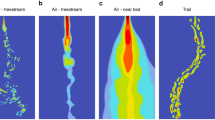Summary
-
1.
The tympanic organs ofSpodoptera frugiperda, Mocis latipes, Erebus odorata, Maenas jussiae andEmpyreuma pugione (Lepidoptera) were stimulated with acoustic pulses of 3.5 ms duration, 20 kHz intrinsic frequency and intensities ranging from 35 to 100 dB (0 dB=2×10−5 N/m2). The electric activity of the auditory receptors was recorded with a stainless steel hook electrode at the tympanic nervelet, in the zone where it adjoins the alar nerve in the mesothorax.
-
2.
The increase of stimulus intensity above threshold evokes a linear increment in the number of spikes per acoustic pulse of the auditory receptors (A1 and A2 cells), without saturation even with the highest intensities used. At the same time the latency period of the response of both auditory receptors decreases exponentially. The interspike intervals during the response of these cells change with stimulus intensity, as well as with the time-course of the response.M. latipes shows the briefest interval value, around 1.0 ms, whileE. pugione has the longest, around 1.8 ms.S. frugiperda andM. latipes show brief latency periods (less than 2.0 ms for intensities 20 dB above the A1-cell threshold), and during the response the briefest interval occurs sooner than in the other three species, which show longer latency periods (around 3.0 ms); the minimum interspike interval value is reached later.
-
3.
These interspecific differences may be due to the temporal course of the generator potential of the auditory receptors.
Similar content being viewed by others
Abbreviations
- AP :
-
action potential
References
Adams WB (1971) Intensity characteristics of the noctuid acoustic receptor. J Gen Physiol 58:562–579
Coro F (1979) Morpho-functional organization of auditory receptors inEmpyreuma pugione (L.) (Lepidoptera). PhD Thesis (in Russian), Havana-Moscow
Coro F, Pérez M (1984) Intensity coding by auditory receptors inEmpyreuma pugione (Lepidoptera, Ctenuchidae). J Comp Physiol A 154:287–295
Eggers F (1916) Notes supplementaires sur l'organe tympanal thoracal des noctuides et de quelques autres familles de Lepidoptères. Rev Russe Entomol 16:249–265
Ghiradella H (1971) Fine structure of the noctuid moth ear. I. The transducer area and connection to the tympanic membrane inFeltia subgothica (Haworth). J Morphol 134:21–45
Popov AV, Shuvalov VF, Svietlogorskaya ID, Markovich AM (1974) Acoustic behavior and auditory systems in insects. In: Schwartzkopff J (ed) Mechanoreception. Westdeutscher Verlag, Opladen, pp 281–306
Rheinlaender J, Mörchen A (1979) Time-intensity trading in locust auditory interneurons. Nature 281:672–674
Roeder KD (1962) Interaction between flying bats and moths by ultrasound. In: Bernard E (ed) Biological prototypes and synthetic systems. Plenum Press, New York, pp 75–82
Roeder KD (1964) Aspects of the noctuid tympanic nerve response having significance in the avoidance of bats. J Insect Physiol 10:529–546
Roeder KD (1965) Moths and ultrasound. Sci Am 212:94–102
Roeder KD (1966) Auditory system of noctuid moths. Science 154:1515–1521
Roeder KD (1967) Nerve cells and insect behavior. Harvard University Press, Cambridge, Mass.
Roeder KD (1973) Brain interneurons in noctuoid moths: binaural excitation and slow potentials. J Insect Physiol 19:1591–1601
Roeder KD (1974) Responses of the less sensitive acoustic sense cells in the tympanic organs of some noctuid and geometrid moths. J Insect Physiol 20:55–66
Roeder KD, Treat AE (1960) The acoustic detection of bats by moths. Proceedings of the XI International Entomological Congress, pp 150–158
Roeder KD, Treat AE (1961) The detection and evasion of bats by moths. Am Sci 49:135–148
Römer H (1976) Die Informationsverarbeitung tympanaler Rezeptorelemente vonLocusta migratoria (Acrididae, Orthoptera). J Comp Physiol 109:101–122
Suga N (1961) Functional organization of two tympanic neurons in noctuid moths. Jpn J Physiol 11:666–677
Author information
Authors and Affiliations
Rights and permissions
About this article
Cite this article
Pérez, M., Coro, F. Physiological characteristics of the tympanic organ in noctuoid moths. J. Comp. Physiol. 154, 441–447 (1984). https://doi.org/10.1007/BF00605244
Accepted:
Issue Date:
DOI: https://doi.org/10.1007/BF00605244




